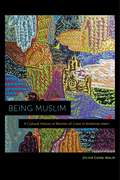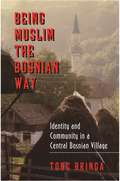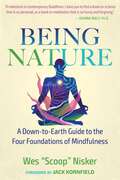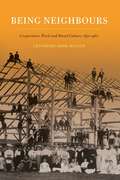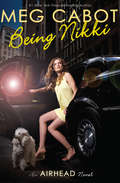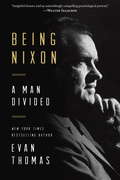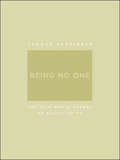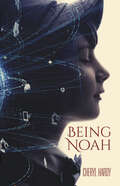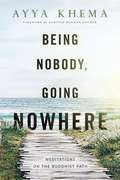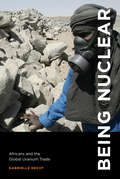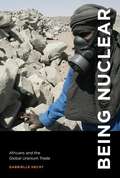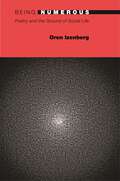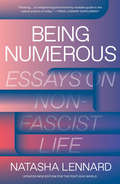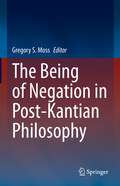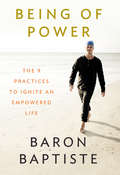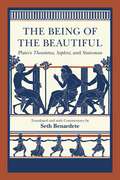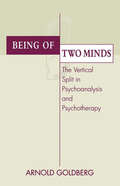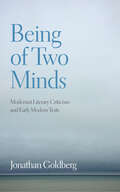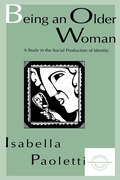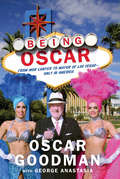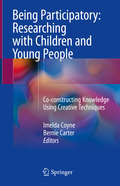- Table View
- List View
Being Muslim: A Cultural History of Women of Color in American Islam
by Sylvia Chan-Malik2018 Outstanding Academic Title, given by Choice MagazineAn exploration of twentieth and twenty-first century U.S. Muslim womanhood that centers the lived experience of women of color For Sylvia Chan-Malik, Muslim womanhood is constructed through everyday and embodied acts of resistance, what she calls affective insurgency. In negotiating the histories of anti-Blackness, U.S. imperialism, and women’s rights of the twentieth and twenty-first centuries, Being Muslim explores how U.S. Muslim women’s identities are expressions of Islam as both Black protest religion and universal faith tradition. Through archival images, cultural texts, popular media, and interviews, the author maps how communities of American Islam became sites of safety, support, spirituality, and social activism, and how women of color were central to their formation. By accounting for American Islam’s rich histories of mobilization and community, Being Muslim brings insight to the resistance that all Muslim women must engage in the post-9/11 United States. From the stories that she gathers, Chan-Malik demonstrates the diversity and similarities of Black, Arab, South Asian, Latina, and multiracial Muslim women, and how American understandings of Islam have shifted against the evolution of U.S. white nationalism over the past century. In borrowing from the lineages of Black and women-of-color feminism, Chan-Malik offers us a new vocabulary for U.S. Muslim feminism, one that is as conscious of race, gender, sexuality, and nation, as it is region and religion.
Being Muslim and Working for Peace
by Raphael SusewindBeing Muslim and Working for Peace explores various ways in which religious beliefs, ritual practices and dynamics of belonging impact the politics of Muslim peace activists in Gujarat, and traces how their activism in turn transforms their sense of being. It challenges popular notions about Muslims in India and questions ill-conceived research designs in the sociology of religion. More than a decade after the 2002 riots in Gujarat, this empirical typology sheds light on the diversity of Muslim civil society and Muslims in civil society. Muslim peace activists in post-conflict Gujarat experience the 'ambivalence of the sacred' as a personal dynamic; as faith-based actors, secular technocrats, emancipating women and doubting professionals, they struggle for a better future in diverse and sometimes surprising ways. By taking their diversity seriously, this book sharpens the distinction between ambivalence and ambiguity, and provides fresh perspectives on religion and politics in India today.
Being Muslim the Bosnian Way: Identity and Community in a Central Bosnian Village (Princeton Studies in Muslim Politics #55)
by Tone Bringa"I have been able to follow a Bosnian community over a period of six years, during which it has undergone dramatic changes. In the late 1980s people were working hard against economic crisis. In 1990 they were full of optimism for the future. In January 1993 the village was in fear, surrounded by war on all sides. In April 1993 it was attacked by Croat forces. In October 1993 none of the Muslims in the village remained. They had either fled, been placed in detention camps, or been killed." <P><P>Thus begins Tone Bringa's moving ethnographic account of Bosnian Muslims' lives in a rural village located near Sarajevo. Although they represent a majority of the population in the Republic of Bosnia and Herzegovina, Bosnian Muslims are still members of a minority culture in the region that was once Yugoslavia. The question of ethno- national identity has become paramount in this society, and the author focuses on religion as the defining characteristic of identity. Bringa pays particular attention to the roles that women play in defining Muslim identities, and she examines the importance of the household as a Muslim identity sphere. In so doing, she illuminates larger issues of what constitutes "nationality." This is a gripping and heartfelt account of a community that has been torn apart by ethno-political conflict. It will attract readers of all backgrounds who want to learn more about one of the most intractable wars of the late twentieth century and the people who have been so tragically affected.
Being Nature: A Down-to-Earth Guide to the Four Foundations of Mindfulness
by Wes Nisker• Provides a practical program, complete with enjoyable, even playful meditations, for realizing greater self-awareness, increased wisdom, and happiness• Shows how recent discoveries in physics, evolutionary biology, and psychology express in scientific terms the same insights the Buddha discovered more than 2,500 years ago• Reveals the origins of attachments, desires, emotions, and thoughts in our own bodiesTaking us on an evolutionary journey to find the origins of emotions, desires, and thoughts in our own bodies, Wes &“Scoop&” Nisker shows not only how cutting-edge science is proving the tenets of the Buddha but also how we can interpret the traditional practices of Buddhism through this scientific lens for more personal freedom and peace of mind. Using the traditional Buddhist meditation series of the Four Foundations of Mindfulness as a framework, Nisker offers a witty narrative along with practical meditations and exercises to train the mind to overcome painful conditioning and gain greater self-awareness, increased wisdom, and happiness. He shows how recent discoveries in physics, evolutionary biology, and psychology express in scientific terms the same insights the Buddha discovered more than 2,500 years ago, such as the impermanence of the body, where thoughts come from, and how the body communicates within itself. Presenting a variety of new ways to harness the power of mindfulness to transform our understanding of both ourselves and the world, Nisker teaches us how to put our understanding of evolution in the service of spiritual awakening.
Being Neighbours: Cooperative Work and Rural Culture, 1830–1960 (McGill-Queen's Rural, Wildland, and Resource Studies)
by Catharine Anne WilsonThroughout history, farm families have shared work and equipment with their neighbours to complete labour-intensive, time-sensitive, and time-consuming tasks. They benefitted materially and socially from these voluntary, flexible, loosely structured networks of reciprocal assistance, making neighbourliness a vital but overlooked aspect of agricultural change. Being Neighbours takes us into the heart of neighbourhood – the set of people near and surrounding the family – through an examination of work bees in southern Ontario from 1830 to 1960. The bee was a special event where people gathered to work on a neighbour’s farm like bees in a hive for a wide variety of purposes, including barn raising, logging, threshing, quilting, turkey plucking, and apple paring. Drawing on the diaries of over one hundred men and women, Catharine Wilson takes readers into families’ daily lives, the intricacies of their labour exchange, and their workways, feasts, and hospitality. Through the prism of the bee and a close reading of the diaries, she uncovers the subtle social politics of mutual dependency, the expectations neighbours had of each other, and their ways of managing conflict and crisis. This book adds to the literature on cooperative work that focuses on evaluating its economic efficiency and complicates histories of capitalism that place communal values at odds with market orientation. Beautifully written, engaging, and richly detailed and illustrated, Being Neighbours reveals the visceral textures of rural life.
Being Nikki: An Airhead Novel (Airhead #2)
by Meg CabotThe second book in the New York Times bestselling phenomenon from Meg Cabot.It's not easy being Nikki. Ever since former tomboy Emerson Watts' accident at the SoHo Stark Megastore--and subsequent brain transplant into the body of teen supermodel Nikki Howard--her life has changed dramatically. Em's trying to handle the demands of school, modeling, fending off Nikki's creepy ex-boyfriends, and living with celebutante Lulu Collins.Will this former tomboy be able to make it in the world of high fashion? What will happen if she can't?
Being Nixon: A Man Divided
by Evan ThomasEvan Thomas delivers the best single-volume biography of Richard Nixon to date, a radical, unique portrait of a complicated figure who was both determinedly optimistic and tragically flawed. The New York Times bestselling author of Ike's Bluff and Sea of Thunder, Thomas brings new life to one of American history's most infamous, paradoxical, and enigmatic politicians, dispensing with myths to achieve an intimate and evenhanded look at the actual man. What drove a painfully shy outcast in elite Washington society--a man so self-conscious he refused to make eye contact during meetings--to pursue power and public office? How did a president so attuned to the American political id that he won reelection in a historic landslide lack the self-awareness to recognize the gaping character flaws that would drive him from office and forever taint his legacy? In Being Nixon, Evan Thomas peels away the layers of the complex, confounding figure who became America's thirty-seventh president. The son of devout Quakers, Richard Nixon (not unlike his rival John F. Kennedy) grew up in the shadow of an older, favored brother and thrived on conflict and opposition. Through high school and college, in the navy and in politics, he was constantly leading crusades and fighting off enemies real and imagined. As maudlin as he was Machiavellian, Nixon possessed the plainspoken eloquence to reduce American television audiences to tears with his career-saving "Checkers" speech; meanwhile, his darker half hatched schemes designed to take down his political foes, earning him the notorious nickname "Tricky Dick." Drawing on a wide range of historical accounts, Thomas reveals the contradictions of a leader whose vision and foresight led him to achieve détente with the Soviet Union and reestablish relations with communist China, but whose underhanded political tactics tainted his reputation long before the Watergate scandal. One of the principal architects of the modern Republican Party and its "silent majority" of disaffected whites and conservative ex-Dixiecrats, Nixon was also deemed a liberal in some quarters for his efforts to desegregate Southern schools, create the Environmental Protection Agency, and end the draft. A deeply insightful character study as well as a brilliant political biography, Being Nixon offers a surprising look at a man capable of great bravery and extraordinary deviousness--a balanced portrait of a president too often reduced to caricature.
Being No One: The Self-Model Theory of Subjectivity
by Thomas MetzingerAccording to Thomas Metzinger, no such things as selves exist in the world: nobody ever had or was a self. All that exists are phenomenal selves, as they appear in conscious experience. The phenomenal self, however, is not a thing but an ongoing process; it is the content of a "transparent self-model." In Being No One, Metzinger, a German philosopher, draws strongly on neuroscientific research to present a representationalist and functional analysis of what a consciously experienced first-person perspective actually is. Building a bridge between the humanities and the empirical sciences of the mind, he develops new conceptual toolkits and metaphors; uses case studies of unusual states of mind such as agnosia, neglect, blindsight, and hallucinations; and offers new sets of multilevel constraints for the concept of consciousness. Metzinger's central question is: How exactly does strong, consciously experienced subjectivity emerge out of objective events in the natural world? His epistemic goal is to determine whether conscious experience, in particular the experience of being someone that results from the emergence of a phenomenal self, can be analyzed on subpersonal levels of description. He also asks if and how our Cartesian intuitions that subjective experiences as such can never be reductively explained are themselves ultimately rooted in the deeper representational structure of our conscious minds.
Being Noah
by Cheryl HardyTen-year-old Noah has a gift beyond the natural gifts of humans. This ability allows him to hear the thoughts of the family therapy dog, Ozzie, and to see visions of the future, which go unnoticed by the people who should love him and trust him the most.Noah&’s brother Sean is on the autism spectrum and receives more attention from their parents, at least more than Noah gets…which causes him to feel angst, sadness, frustration, and jealousy. Noah wants what all children want, love and acceptance. He needs his parents and grandmother to trust him and help him gain confidence in himself. Being Noah is a story of a boy believing in himself, even when others don&’t, and finding a way to use his gifts so he can affect change in the world and lives of those around him. Being Noah is Margaret Cheryl Hardy&’s first and only work, written in the MFA program at Western Colorado University. "A thoughtful book that is well-paced and includes enough realism to balance the mystical and spiritual content. A great book for introspection and discussion after reading."—School Library Journal
Being Nobody, Going Nowhere
by Ayya Khema Zoketsu Norman FischerIn this lucid classic, beloved teacher Ayya Khema introduces the reader to the essence of the Buddhist path. She addresses the how and why of meditation, providing a clear framework for understanding the nature of karma and rebirth and the entirety of the eightfold path. With specific, practical advice Ayya Khema illuminates the practices of compassion and sympathetic joy and offers forthright guidance in working with the hindrances that we all encounter in meditation. Few introductory books are both simple and profound. Being Nobody, Going Nowhere is both.
Being Nuclear: Africans and the Global Uranium Trade (The\mit Press Ser.)
by Gabrielle HechtThe hidden history of African uranium and what it means—for a state, an object, an industry, a workplace—to be “nuclear.”Uranium from Africa has long been a major source of fuel for nuclear power and atomic weapons, including the bomb dropped on Hiroshima. In 2003, after the infamous “yellow cake from Niger,” Africa suddenly became notorious as a source of uranium, a component of nuclear weapons. But did that admit Niger, or any of Africa's other uranium-producing countries, to the select society of nuclear states? Does uranium itself count as a nuclear thing? In this book, Gabrielle Hecht lucidly probes the question of what it means for something—a state, an object, an industry, a workplace—to be “nuclear.” Hecht shows that questions about being nuclear—a state that she calls “nuclearity”—lie at the heart of today's global nuclear order and the relationships between “developing nations” (often former colonies) and “nuclear powers” (often former colonizers). Hecht enters African nuclear worlds, focusing on miners and the occupational hazard of radiation exposure. Could a mine be a nuclear workplace if (as in some South African mines) its radiation levels went undetected and unmeasured? With this book, Hecht is the first to put Africa in the nuclear world, and the nuclear world in Africa. By doing so, she remakes our understanding of the nuclear age.
Being Nuclear
by Gabrielle HechtUranium from Africa has long been a major source of fuel for nuclear power and atomic weapons, including the bomb dropped on Hiroshima. In 2002, George W. Bush claimed that Saddam Hussein had "sought significant quantities of uranium from Africa" (later specified as the infamous "yellowcake from Niger"). Africa suddenly became notorious as a source of uranium, a component of nuclear weapons. But did that admit Niger, or any of Africa's other uranium-producing countries, to the select society of nuclear states? Does uranium itself count as a nuclear thing? In this book, Gabrielle Hecht lucidly probes the question of what it means for something--a state, an object, an industry, a workplace--to be "nuclear. " Hecht shows that questions about being nuclear--a state that she calls "nuclearity"--lie at the heart of today's global nuclear order and the relationships between "developing nations" (often former colonies) and "nuclear powers" (often former colonizers). Nuclearity, she says, is not a straightforward scientific classification but a contested technopolitical one. Hecht follows uranium's path out of Africa and describes the invention of the global uranium market. She then enters African nuclear worlds, focusing on miners and the occupational hazard of radiation exposure. Could a mine be a nuclear workplace if (as in some South African mines) its radiation levels went undetected and unmeasured? With this book, Hecht is the first to put Africa in the nuclear world, and the nuclear world in Africa. Doing so, she remakes our understanding of the nuclear age.
Being Numerous: Poetry and the Ground of Social Life (20/21 #11)
by Oren Izenberg"Because I am not silent," George Oppen wrote, "the poems are bad." What does it mean for the goodness of an art to depend upon its disappearance? In Being Numerous, Oren Izenberg offers a new way to understand the divisions that organize twentieth-century poetry. He argues that the most important conflict is not between styles or aesthetic politics, but between poets who seek to preserve or produce the incommensurable particularity of experience by making powerful objects, and poets whose radical commitment to abstract personhood seems altogether incompatible with experience--and with poems. Reading across the apparent gulf that separates traditional and avant-garde poets, Izenberg reveals the common philosophical urgency that lies behind diverse forms of poetic difficulty--from Yeats's esoteric symbolism and Oppen's minimalism and silence to O'Hara's joyful slightness and the Language poets' rejection of traditional aesthetic satisfactions. For these poets, what begins as a practical question about the conduct of literary life--what distinguishes a poet or group of poets?--ends up as an ontological inquiry about social life: What is a person and how is a community possible? In the face of the violence and dislocation of the twentieth century, these poets resist their will to mastery, shy away from the sensual richness of their strongest work, and undermine the particularity of their imaginative and moral visions--all in an effort to allow personhood itself to emerge as an undeniable fact making an unrefusable claim.
Being Numerous: Essays on Non-Fascist Life
by Natasha LennardAn urgent challenge to the prevailing moral order from one of the freshest, most compelling voices in radical politics todayBeing Numerous shatters the mainstream consensus on politics and personhood, offering in its place a bracing analysis of a perilous world and how we should live in it. Beginning with an interrogation of what it means to fight fascism, Natasha Lennard explores the limits of individual rights, the criminalization of political dissent, the myths of radical sex, and the ghosts in our lives. At once politically committed and philosophically capacious, Being Numerous is a revaluation of the idea that the personal is political, and situates as the central question of our time—How can we live a non-fascist life?
The Being of Negation in Post-Kantian Philosophy
by Gregory S. MossBy drawing on the insights of diverse scholars from around the globe, this volume systematically investigates the meaning and reality of the concept of negation in Post-Kantian Philosophy—German Idealism, Early German Romanticism, and Neo-Kantianism. The reader benefits from the historical, critical, and systematic investigations contained which trace not only the significance of negation in these traditions, but also the role it has played in shaping the philosophical landscape of Post-Kantian philosophy. By drawing attention to historically neglected thinkers and traditions, and positioning the dialogue within a global and comparative context, this volume demonstrates the enduring relevance of Post-Kantian philosophy for philosophers thinking in today’s global context. This text should appeal to graduate students and professors of German Idealism, Post-Kantian philosophy, comparative philosophy, German studies, and intellectual history.
Being of Power: The 9 Practices To Ignite An Empowered Life
by Baron BaptisteWe live in a world where we’re all about updating. We update our computers, phones, cars, careers – even our partners.Well, now it’s time to update your personal philosophy. In essence, it’s time to update you.Being of Power is about accessing a new kind of power. Not just with others, but with yourself – your experiences, your work, your purpose . . . how you relate to everything in your life. Here you will find the tools that allow you to break through the limiting views that have been keeping you stuck, frustrated, and unfulfilled; expand your perspective to see new pathways and possibilities; and come into your genuine, best self now.Baron Baptiste presents the nine practices as the stepping-stones on the path back to your essential authenticity, which is where your greatest power lives. These are practices to put into action minute by minute, day by day. You won’t master them all at once; instead, you’ll work on them – and they’ll work on you – again and again until eventually you come to embody them as a natural way of being. This is how you transform.Written in a highly accessible, conversational style, this book will put you in alignment with your highest intentions and make them reality, which is now possible in every moment, no matter what your journey has brought you up to now.
The Being of the Beautiful: Plato's Theaetetus, Sophist, and Statesman
by Plato Seth BenardeteThe Being of the Beautiful collects Plato’s three dialogues, the Theaetetus, Sophist, and Statesmen, in which Socrates formulates his conception of philosophy while preparing for trial. Renowned classicist Seth Benardete’s careful translations clearly illuminate the dramatic and philosophical unity of these dialogues and highlight Plato’s subtle interplay of language and structure. Extensive notes and commentaries, furthermore, underscore the trilogy’s motifs and relationships. “The translations are masterpieces of literalness. . . . They are honest, accurate, and give the reader a wonderful sense of the Greek.”—Drew A. Hyland, Review of Metaphysics
Being of Two Minds: The Vertical Split in Psychoanalysis and Psychotherapy
by Arnold I. GoldbergFrom the unfaithful husband to the binge eater, from the secret cross-dresser to the pilferer of worthless items, there are those who seem to live two lives, to be divided selves, to be literally of two minds. This division or "vertical split" appears in a person at odds with himself, a person who puzzles over, and even heartily dislikes, that parallel person who behaves in so repugnant a manner. In Being of Two Minds, Arnold Goldberg provides trenchant insight into such divided minds - their origins, their appearances, and their treatment. Goldberg's inquiry into divided minds leads to a return to the psychoanalytic concept of disavowal, which forms the basis of the vertical split. Goldberg explores the developmental circumstances that tend to a reliance on disavowal, provides numerous examples of the emergence of disavowal in the treatment situation, and considers the therapeutic approaches through which disavowal may be addressed. He is especially perceptive in discussing the manner in which the therapist's own tendency to disavow may collusively interact with that of the patient. Goldberg considers the full range of splits to which disavowal gives rise, from circumscribed instances of dissociation to the much-debated multiple personality disorders. He gives special attention to the role of the vertical split in patients with behavior disorders; here his thoughtful insights point to a treatment approach that significantly differs both from the simple ascription of a 'self disorder' and from the usual pedagogical emphasis on issues of self-control and/or punishment. As Goldberg shows, the repugnance felt by many therapists for offensive behaviors emanating from the patient's parallel self are frequently shared by the patient, who commonly despises misbehavior that he is unable to understand. Being of Two Minds begins to formulate just such understanding, to the great benefit of patient and therapist alike.
Being of Two Minds: Modernist Literary Criticism and Early Modern Texts
by Jonathan GoldbergBeing of Two Minds examines the place that early modern literature held in Modernist literary criticism. For T. S. Eliot, Virginia Woolf, and William Empson, the early modern period helps model a literary future. At stake in their engagements across time were ontological questions about literature and its ability to mediate between the one and the many, the particular and the general, life and death, the past and the present. If reading and writing literature enables the mind to be in two places at once, creative experience serves as a way to participate in an expanded field of consciousness alongside mortality.Goldberg reads the readings that these modernists performed on texts that Eliot claimed for the canon like the metaphysical poets and Jacobean dramatists, but also Shakespeare, Milton, Montaigne, and Margaret Cavendish. Ontological concerns are reflected in Eliot’s engagement with Aristotle’s theory of the soul and Empson’s Buddhism. These arguments about being affect minds and bodies and call into question sexual normativity: Eliot glances at a sodomitical male-male mode of literary transmission; Woolf produces a Judith Shakespeare to model androgynous being; Empson refuses to distinguish activity from passivity to rewrite gender difference.The work of one of our leading literary and cultural critics, Being of Two Minds spans centuries to show how the most compelling and surprising ideas about mind, experience, and existence not only move between early modernity, high modernism, and our own moment, but are also constituted through that very movement between times and minds.
Being An Older Woman: A Study in the Social Production of Identity (Everyday Communication Series)
by Isabella PaolettiThe study presented in this volume examines how older women's identities are socially constructed and, in particular, how they can be influenced by institutional intervention. The interest in identity production is not only theoretical, but also practical. Different perceptions of oneself as an older woman involve considerable differences in the definition of that person's possible sphere of action, and therefore, in her life perspectives. The data -- collected during a four-year project studying older women -- consist of video recordings of the committee meetings of the Older Women's Group of Perugia, Italy. Other video recordings of theater workshops and of the management committee meetings of the Senior Citizen Centers in Perugia are used as a source of comparison. Transcripts of the video material are analyzed through a detailed discourse analysis within an ethnomethodological framework. The data are used to explore how gender and age identities are interactionally constructed in specific institutional contexts. The first part of the book focuses on the interactional construction of aging. It shows how "being old" is constructed conversationally, in particular, through the use of membership categories. Distancing from the category "old" and denial of aging are frequently encountered conversational moves. However, the category is perceived as acceptable, even desired and invoked, when it becomes an institutionally relevant category, giving access to interesting activities or special benefits. The second part of the book explores gender identification. Conflict among different institutional subjects is shown to fade into gender conflict. The study analyzes how institutional interventions exert a powerful influence on older women's identities, giving them new opportunities for action. It also looks at how the conversational styles, attitudes, and activities of specific women influence the features of those very institutions. In short, this book describes the discourse and social practices that constitute older women's identities -- helping to identify and deconstruct stereotypes that tend to produce marginalization of older people. The book's existence is itself a contribution to the construction of older women as busy, lively, appealing human beings; it is the first research publication to emerge from The European Older Women's Project. Of interest to those in any discipline studying the topics of ethnomethodology, gender, aging, and identity.
Being Online: On Computing, Data, the Internet, and the Cloud
by Jian WangA pioneer of cloud computing and big data offers his vision of the future world taking shape around us. Jian Wang was the founder and architect of Alibaba's cloud and has been the driving force behind its technology innovations. He was also the founder of the City Brain initiative to develop a new digital infrastructure for sustainable cities. Being Online is his meditation on the moment we are in, as the digital era shifts to the internet era, spawning new innovations at a seemingly dizzying pace: cloud computing, 5G, artificial intelligence, big data, wearables, robots, virtual reality, the internet of things, blockchain, and more. For Wang, the invisible hand that connects them is being online. The conjunction of computing, data, and the internet has erased the difference between being online and off. When computing can be done in the cloud, it is on the road to becoming a utility. When data is connected, making it big, its usefulness multiplies exponentially in unforeseeable ways, as does its value. This moment will be as transformative for humanity as Henry Ford's production line. Data is changing the nature of business. Computing is reshaping the economy. The cloud will help us do things we could never do before, at scales that were previously impossible. It will reshape our vision of the world, as electrification once did and, more recently, the transition from analog to digital. While telling the story of Alibaba&’s breakthroughs and the development of his own understanding of the internet, Jian Wang's visionary book lays out the implications of this shift and how to think about being online.
Being Oscar: From Mob Lawyer to Mayor of Las Vegas
by Oscar GoodmanIn Being Oscar,one of America's most celebrated criminal defense attorneys recounts the stories and cases of his epic life. The Mafia's go-to defender, he has tried an estimated 300 criminal cases, and won most of them. His roster of clients reads like a history of organized crime: Meyer Lansky, Nicky Scarfo, and "Lefty" Rosenthal, as well as Mike Tyson and boxing promoter Don King, along with a midget, a dentist, and a federal judge.After thirty-five years as a defender, he ran for mayor of Las Vegas, and America's greatest Mob lawyer became the mayor of its sexiest city. He was so popular his image appeared on the $5, $25, and $100 chips. While mayor of Vegas, he starred on the screen in Rush Hour 2 and CSI. He is as large a character in the history of organized crime as any of his clients and as legendary a figure in the history of Las Vegas as the entrepreneurs (his friends and clients) who built the city. This is his astonishing story--the truth, the whole truth, and nothing but the truth.
Being Participatory: Co-constructing Knowledge Using Creative Techniques
by Imelda Coyne Bernie CarterThis book provides a clear framework for conducting participatory research with children and young people supported with practical examples from international research studies. Our aim is to encourage more participatory research with children and young people on all matters that affect their lives. This book illustrates innovative ways of being participatory and sheds new light on involvement strategies that play to children’s and young people’s competencies. Participatory research is based on the recognition of children and young people as active contributors rather than objects of research. Participatory researchers support and value the voices of children and young people in all matters that concern them. Core to participatory research practice is a strengths-based approach that aims to promote the active engagement of children and young people in all stages of research, from inception to implementation and beyond. Engagement of children and young people requires the use of creative, participatory methods, tools and involvement strategies to reveal children’s competencies. This book shares knowledge about creative participatory techniques that can enable and promote children’s ways of expressing their views and experiences. The book provides guidance on appropriate techniques that reduce the power differential in the adult-child relationship and which optimise children’s abilities to participate in research. This book is targeted at researchers, academics, and practitioners who need guidance on what tools are available, how the tools can be used, advantages and challenges, and how best to involve children in all stages of a research project. It will provide several examples of how children can have an active participatory role in research. There is increasing interest in involving children as co-researchers but little guidance on how this can be done. This book fills a this gap by addressing all of these issues and by providing worked examples from leading researchers and academics.
Being Participatory: Co-constructing Knowledge Using Creative, Digital and Innovative Techniques
by Imelda Coyne Bernie CarterThe second edition of this book provides a clear framework for conducting participatory research with children and young people supported by practical examples from international research studies. Our aim is to encourage more participatory research with children and young people on all matters that affect their lives. This book illustrates innovative ways of being participatory and how such methods can promote the inclusion of children and young people with diverse experiences and backgrounds. It sheds new light on involvement strategies that recognise agency and that play to children and young people's strengths.The international experts in this book share knowledge built from their wealth of experience in undertaking participatory research with children and young people using creative techniques that can enable and promote ways of expressing their views and experiences. The book provides guidance on appropriate techniques that can reduce the power differential between adultresearchers and children and young people as participants. These techniques help to optimise their abilities to participate in research. There is increasing interest in involving children and young people as co-researchers but little guidance on how this can be done. This book fills a gap in the current literature by addressing all these issues outlined above and by providing worked examples from leading researchers and academics. Building on the success of the first edition and, with an additional three chapters, this second edition is sure to have wide appeal to researchers across a range of different disciplines. This book is targeted at researchers, academics, and practitioners who need guidance on what tools are available, how the tools can be used, advantages and challenges, and how best to involve children and young people in all stages of a research project.
Being Patient with Cookie Monster: Sesame Street Monster Meditation in collaboration with Headspace (Monster Meditation)
by Random HouseCookie Monster learns simple meditation techniques and plays a fun game to help be more patient--based on the popular Sesame Street Monster Meditation video on YouTube made in collaboration with the mindfulness app Headspace.Sometimes everyone needs to slow down and take some cleansing belly breaths--even Cookie Monster! This terrific board book features Cookie Monster learning a calming game to help pass the time as he waits for his cookies to finish baking. The game is a fun and simple one that all young boys and girls can easily play whenever they need to be patient.This is Book 1 in a series of 6 books, all inspired by the popular Sesame Street Monster Meditation videos on YouTube, that will help young girls and boys learn mindfulness techniques along with their favorite characters. The videos are made in collaboration with Headspace, the mindfulness app. Sesame Workshop, the nonprofit educational organization behind Sesame Street, aims to help kids grow smarter, stronger, and kinder through its many unique domestic and international initiatives. These projects cover a wide array of topics for families around the world.
